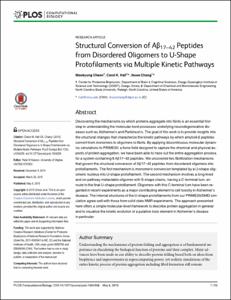Department of Brain Sciences
Theoretical and Computational Biophysics Laboratory
1. Journal Articles
Structural Conversion of A beta(17-42) Peptides from Disordered Oligomers to U-Shape Protofilaments via Multiple Kinetic Pathways
- Title
- Structural Conversion of A beta(17-42) Peptides from Disordered Oligomers to U-Shape Protofilaments via Multiple Kinetic Pathways
- Author(s)
- Cheon, Mookyung ; Hall, Carol K. ; Chang, Iksoo
- Issued Date
- 2015-05
- Citation
- PLoS Computational Biology, v.11, no.5
- Type
- Article
- Keywords
- Alzheimer Disease ; ALZHEIMERS-DISEASE ; Amyloid Beta Protein ; Amyloid Beta Protein[17-42] ; Article ; BETA-AMYLOID FIBRILS ; Carboxy Terminal Sequence ; COMPUTER-SIMULATION ; Conformational Transition ; Controlled Study ; Cytotoxicity ; Degenerative Disease ; Energy Landscape ; IN-SILICO ; ION CHANNELS ; Kinetics ; MODEL ; MOLECULAR-DYNAMICS SIMULATIONS ; Molecular Dynamics ; Monomer ; Nuclear Magnetic Resonance ; OLIGOMER ; Parkinson Disease ; POLYMORPHISM ; Protein Aggregation ; Protein Conformation ; PROTEIN OLIGOMERIZATION ; Unclassified Drug
- ISSN
- 1553-734X
- Abstract
- Discovering the mechanisms by which proteins aggregate into fibrils is an essential first step in understanding the molecular level processes underlying neurodegenerative diseases such as Alzheimer’s and Parkinson's. The goal of this work is to provide insights into the structural changes that characterize the kinetic pathways by which amyloid-β peptides convert from monomers to oligomers to fibrils. By applying discontinuous molecular dynamics simulations to PRIME20, a force field designed to capture the chemical and physical aspects of protein aggregation, we have been able to trace out the entire aggregation process for a system containing 8 Aβ17–42 peptides. We uncovered two fibrillization mechanisms that govern the structural conversion of Aβ17–42 peptides from disordered oligomers into protofilaments. The first mechanism is monomeric conversion templated by a U-shape oligomeric nucleus into U-shape protofilament. The second mechanism involves a long-lived and on-pathway metastable oligomer with S-shape chains, having a C-terminal turn, en route to the final U-shape protofilament. Oligomers with this C-terminal turn have been regarded in recent experiments as a major contributing element to cell toxicity in Alzheimer’s disease. The internal structures of the U-shape protofilaments from our PRIME20/DMD simulation agree well with those from solid state NMR experiments. The approach presented here offers a simple molecular-level framework to describe protein aggregation in general and to visualize the kinetic evolution of a putative toxic element in Alzheimer’s disease in particular. © 2015 Cheon et al.
- Publisher
- Public Library of Science
- Files in This Item:
-

10.1371_journal.pcbi.1004258.pdf
기타 데이터 / 6.87 MB / Adobe PDF download
- Appears in Collections:
- Department of Brain Sciences Theoretical and Computational Biophysics Laboratory 1. Journal Articles



